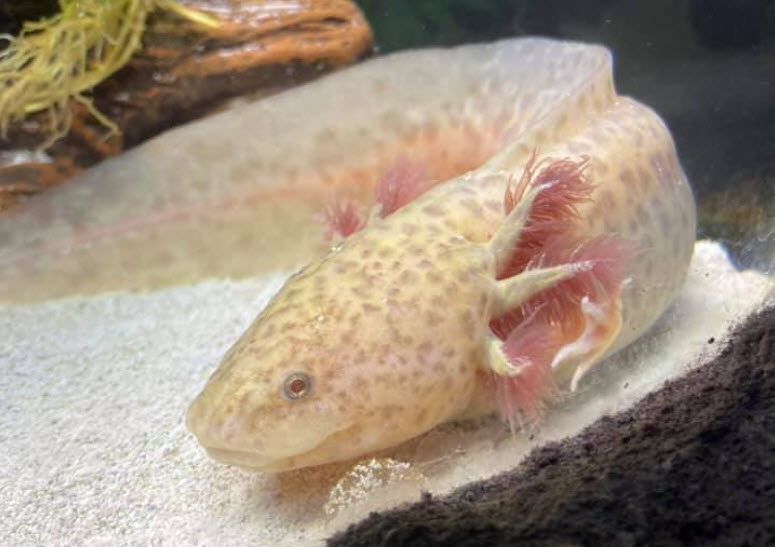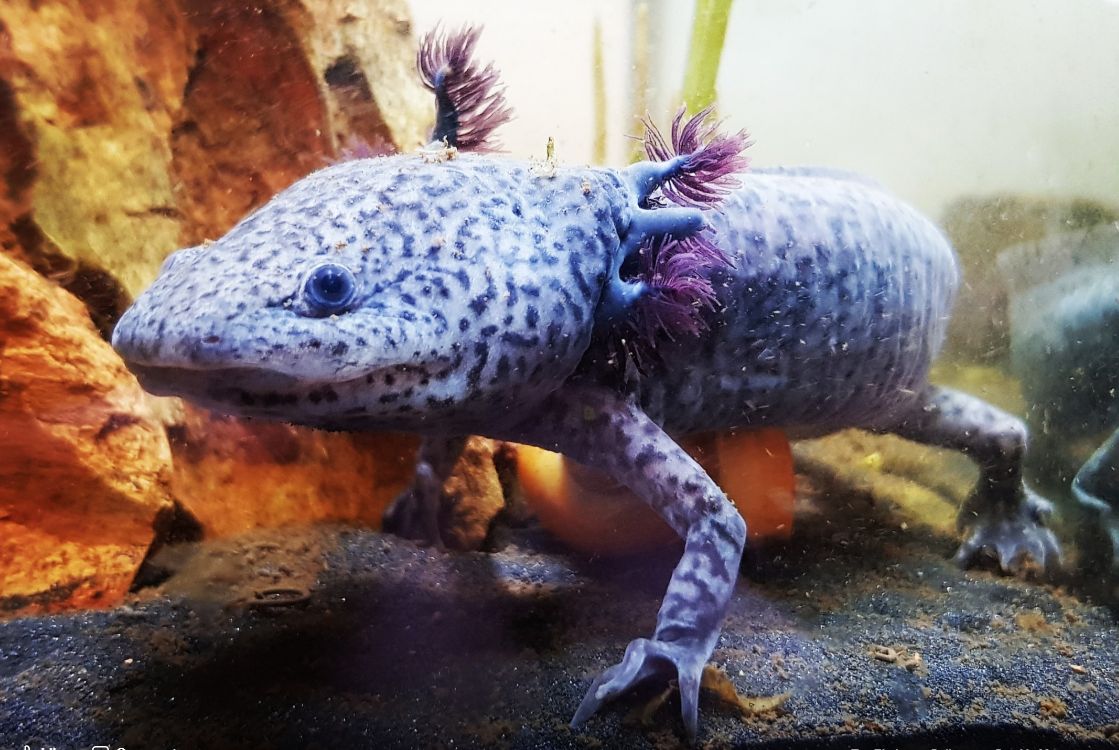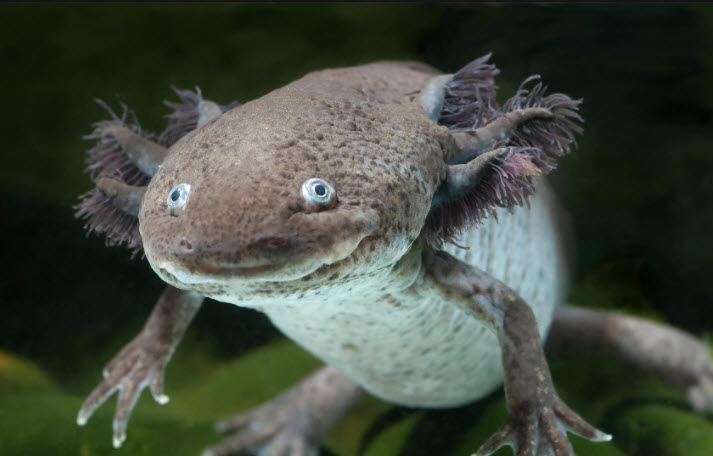
Axolotls are a lot like a cold-water discus in what their “optimum” conditions are. As with discus, there are two opposed methods of keeping axolotl. If one tries to do anything other than these two methods, there CAN be problems. The two methods are:
1, The “ultra-clean way”. This is where everything is frequently changed and cleaned. It has bare bottom tanks, large water changes at least every two days, cleaning the bottom and sides of the aquarium with every water change, and even cleaning the axolotls themselves.
2, The “ultra-filtered way”. This is where each adult axolotl has at least 50 square feet of well-established, uncleaned filter media surface area. Ammonia and nitrites should be zero, but the nitrates can float up. UV is very beneficial.
Both methods ensure the water is low in bacteria and very clean.
.
Axolotls Do Best With VERY Clean Water
.
This clean water requirement is the ONLY real “requirement” for axolotl husbandry.
What follows are the OPTIMUM conditions for axolotls. These conditions are not “rules” and are frequently violated quite successfully. The axolotl has been bred and kept in Europe since 1864. They didn’t have chillers and even biofiltration in those aquariums. So the axolotl is a lot more forgiving than the literature implies.

The other “optimum” condition for axolotls is that they be kept at 630 to 680 F. (170 to 200 C). If the water goes much over 730 (230 C) as an AVERAGE DAILY TEMPERATURE, the axolotl CAN POSSIBLY start having problems. Note that rapid excursions up and down are not harmful to axolotls and that they can take excursions much higher and much lower than these numbers.
And axolotls like to lie motionless at the bottom of a tank. If the water flow is high enough to start moving them around, they can get stressed. They also need to have no other fish in with them. The axolotl’s gills are a nipping target for almost any fish.
The high surface area “optimums” (50 square feet of well-established, uncleaned filter media surface area per axolotl) reflect two facts: first off, the axolotl does best with very clean water. Secondly: the axolotls are very chubby little critters, quite wide and quite plump. This makes them very heavy for their length. And weight is what determines the bioload, not length.

The high filter media surface area “optimum” condition imposes some other challenges. Generally larger filters have larger pumps. The larger the pump the more heat the pump will put into the water. And the higher the water temperature. UV will also add heat. Larger pumps also generally mean higher flow. And axolotls do not like high flow. So chillers CAN be called for as well as devices that baffle and slow the flow out of a pump (large plastic caps generally do the trick).
Note that it is a common myth that a filters flow rate determines its capacity. The surface area of the filter media determines the capacity of a filter.
The ideal filter setup is a large sump filled with foam, K1, or pot scrubbers, coupled with an airlift operating under a gravel filter. The sump should have an external air-cooled LOW VOLUME pump. The sump CAN be connected both to the chiller and to a UV sterilization unit. This is only an ideal. Axolotls are more forgiving than the literature suggests.
There is a myth that axolotls cannot be put in with small gravel as they sometimes eat the gravel. Yes, axolotls eat small gravel particles. But the practice is harmless as the gravel passes through the axolotl quite easily. I recommend under gravels with aquarium gravel with all axolotls. Since bubbles cool the water, an airlift operated under gravel filters is always a good idea in an axolotl aquarium.

Water for Axolotls
Axolotls like (but do NOT NEED) high GH, very low KH, and slightly salty water with a pH between 7.0 and 8.0. This is accomplished by most axolotl breeders by taking RO water and re-mineralizing it with a salt mix called “Modified Holtfreter’s Solution”.
For 50 gallons:
- 2 tablespoons Epsom salts or Magnesium sulfate MgSO4.7H20
- 1 tablespoon Calcium Chloride CaCl2
- 1 teaspoon Potassium Chloride KCl
- One cup of Table Salt or sodium chloride NaCl
Use dry chemicals to do the adds. If one mixes up a stock solution to add, the calcium chloride will heat the solution as it dissolves and it will then precipitate out as calcium sulfate. All the breeders use this salt addition and swear by it. I doubt this is all that necessary. These are only “optimum” conditions and axolotls can do well in just about any water, just like fish.

One claim about the “Modified Holtfreter’s Solution” is that this solution will kill bacteria. This is categorically false. The salt level is far too low to kill bacteria. This solution will supply axolotls with the magnesium and calcium they need for good bones. The skin of axolotls is different from the skin of fish and it passes gases and some ions freely over its whole surface. This is the reason that the axolotl is so sensitive to high ammonia levels.
Note that table salt with anticaking agent and iodide is just fine for making up the solution. Both additives are completely harmless.
Since the toxicity of ammonia rises logarithmically with pH, it is very desirable to have a neutral pH between 6.5 and 8. This is the reason that the “Modified Holtfreter’s solution” has no carbonate in it and won’t result in even a moderate KH. High KH means high pH.

The Science
The above analysis is largely based on the “Compendium of Axolotl Husbandry Methods” 1997. One article in this compendium is from the Sogang University in Korea. This article describes an “ultra-filtered” system where eight 13-gallon axolotl aquariums are filtered through a massive 5.7 cubic foot sand and gravel filter (think a HUGE under gravel filter). The water is changed and the system cleaned once a year.
Then there are a whole series of articles from the likes of the University of California which use the “ultra-clean” methodology and clean everything on the order of once a day or once every other day. They typically change the water every other day.
There are NO articles where a moderate amount of filtration is coupled with a moderate amount of cleaning. Interesting.

Anecdotal Evidence Axolotls are Hardy
I think the following anecdotal comment from one of my readers is apropos:
“Vincent
I thought I would leave a comment in response to your Axolotl article, as I am one of the many people who prove the “which are frequently violated successfully.” part is true.
When I was 5, I got an Axolotl who was kept in a 20G aquarium, and throughout his 10+ year lifespan (I am not entirely sure when he passed but he was the last fish in the house when mum gave up the Hobby) we violated EVERY rule modern Axolotl keepers or other fish keepers have. (Of course several of these rules you already mention as false elsewhere on the site.)
1) His only Filter was an Under Gravel Filter (Which was one of the old 1 foot diameter circular ones, seeded with swamp mud from the back paddock), and the only plant in the tank was Xmas Moss [Strikes: Low Filtration, keeping an Axolotl on Gravel, No UV, introducing wild bugs into the tank, gravel substrate]
2) His Water was 100% pure Rainwater and changed at max once every few Months (Strikes: Soft Water, lack of Water changes, high Nitrates]
3)His tank was basically right next to the kitchen window, and the only time his tank was cooled was when we hit 40C. His tank was never heated, even when we went down to 5C at night. (Those are indoor temps because Australian housing is garbage) Even when it was cooled, it was done using ice blocks placed directly in the water, rather then via fan or ice in a bottle [Strikes: Super high temperatures, low temperatures, rapid temperature fluctuations]
4) He was fed a single small sinking pellet twice a day, EXCEPT when we cooked pasta (when he would get a piece of mince (ground beef)) and when we went on holidays (Where he would be left with Feeder Danios) [Strikes: Red Meat to Fish, Feeder fish, possibly what people would consider under feeding, low quality food (Since it was the 90s in a rural area)]
5)His only other ornament was a bit of PVC tubing with holes in it so he could hide when he wanted too, and a ceramic ‘No Fishing’ sign. [Strikes: Unnatural habitat]
Despite this he was a remarkably healthy fish, The only time this wasn’t the case was when we decided to use a Yabbies (crawfish) instead of Danios. Axel had a habit of eating the fish or yabbie slowly over time and it was not uncommon for him to save 1 long after the Holiday was over (We called it his friend… honestly it was probably just because the last fish was always small enough to hide somewhere)
That Yabby escaping ended up with the Yabby growing big enough to attack Axel and taking large chunk out of Axel’s gills and tail. He did recover though.”
Note I would say the undergravel was very good filtration and adding swamp muck was a good thing. Red meat and feeder fish are also good, not bad. Also note all food has salts in it. So even a 95% water change that only occurs every few months with a heavy feeder like an axolotl will result in some salt always left in the aquarium. What Vincent was doing was very close to what the Sogang University in Korea researchers were doing.

.
Return to Fish Selection Menu
.
Aquarium Science Website
The chapters shown below or on the right side in maroon lead to close to 400 articles on all aspects of keeping a freshwater aquarium. These articles have NO links to profit-making sites and are thus unbiased in their recommendations, unlike all the for-profit sites you will find with Google. Bookmark and browse!

Derek says
Thanks for the response Dave
I ended up getting a 20gal Long tank, a large sponge bubble filter, and a Ziss bubble bio filter from Aquarium Co-op. I also plan on putting in a small UV filter just to be safe. I might move to a UGF once the axolotl gets settled in. I bet the reason people have issues with their axolotls eating gravel is the drop their food on the gravel beds instead of feeding via tweezers.
Thanks for the great site and knowledge. Very nice to have a sane science based resource out here.
Dave says
In reply to Derek …. The whole gravel eating thing is one big myth. Get the small gravel (1/8 to 3/8ths) and do not worry about it. Note I do not generally recommend pea gravel as the food can get trapped in the gravel with no way for the axolotl to get to it.
Derek Allen says
Thinking about getting my son an Axolotl for Xmas. Question about the filtering. I’m a new fish hobbyist but appreciate all this info on your site. I want to do an UGF for the axolotl but being on Reddit I see lots of photos and info about axolotls eating gravel and having to go to the vet. Would it be better to do large rocks over the small pea gravel to keep the axolotl from getting to it?
Dave says
In reply to Jared …. add the chemicals to the tank water as dry chemicals. Otherwise you will get a white precipitate which will cloud the water. And you might pipette solutions down the throat or use a bath. How to do it is in this article: http://aquariumscience.org/index.php/11-15-fish-not-eating/
Jared says
Hi Dave,
I’m wondering if you can expand upon how to mix the ingredients for the Modified Holtfreter’s Solution? I’m just not sure what you mean by, “use dry chemicals to do the adds.” Could I mix each of the dry ingredients in a small amount of water to get them to dissolve, and then add those to the water?
I’m sorry to say that we have a fairly sick axolotl. I’m in the processing of trying antibiotic treatment as well as fenbendazole, but unfortunately we may have figured this out too late as he is no longer eating (I made up the medication as described in your disease section).
Would you have any suggestions on how to get him to eat the medication?
Thanks and I truly appreciate your site, I have learned a TON from you.
Dave says
In reply to John …. No problem at all. Totally harmless. The iodide additive is also harmless.
John says
Hi Dave, looking into Holtfreter’s solution, the table salt I have contains sodium ferrocyanide (anti caking agent) would this be a problem?